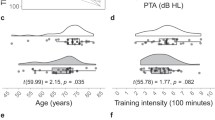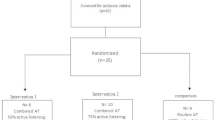Abstract
To investigate the effectiveness of computer-based auditory training on speech-in-noise perception in adults. With no language restriction, 11 databases were searched from 1990 to 2020. We included any clinical trial studies with concurrent comparison groups that examined the effectiveness of computer-based auditory training programs in adults. The primary outcome was a speech in noise perception that was estimated using the “difference pretest–posttest-control” index (dppc2). The risk of bias was assessed using the Cochrane collaboration tool for assessing the risk of bias in randomized trials. The certainty of the evidence was investigated using the GRADE in two primary outcomes. Twenty three studies were included in two subgroups based on primary outcome: 12 studies with speech perception threshold and 11 studies with speech-in-noise test scores. Computer-based auditory training resulted in a speech in noise perception improvement (dppc2: −0.69, 95%CI: −1.11 to −0.26; I2 = 69.6%, p = 0.00) and (dppc2: 0.71, 95%CI: 0.38–1.03, I2: 17.8%, p = 0.27) respectively in both subgroups. 19 studies were judged to have a high risk of bias and 3 studies had a low risk of bias and the strength of the evidence was low in both primary outcomes. This finding indicates that computer-based auditory training can be a moderately effective intervention for speech-in-noise perception in adults. However, due to the low quality of primary studies and the low certainty of the evidence, the results are not yet definite. Prospero registration number: CRD42021233193.





Similar content being viewed by others
Availability of Data and Materials
The data that support the findings of this study are available from the corresponding author upon reasonable request.
Notes
Mean pre-post change in the treatment group minus the mean pre-post change in the control group, divided by the pooled pretest standard deviation.
Standardized mean difference.
Abbreviations
- dppc2 :
-
Difference pretest–posttest-control
References
Deafness and hearing loss. https://www.who.int/news-room/fact-sheets/detail/deafness-and-hearing-loss. Accessed 15 Jul 2022
Shukor NFA, Lee J, Seo YJ, Han W (2020) Efficacy of music training in hearing aid and cochlear implant users: a systematic review and meta-analysis. Clin Exp Otorhinolaryngol. https://doi.org/10.21053/ceo.2020.00101
Recanzone G (2018) The effects of aging on auditory cortical function. Hear Res 366:99–105. https://doi.org/10.1016/j.heares.2018.05.013
Yeend I, Beach EF, Sharma M (2019) Working memory and extended high-frequency hearing in adults. Ear Hear 40:458–467. https://doi.org/10.1097/AUD.0000000000000640
Spankovich C, Gonzalez VB, Su D, Bishop CE (2018) Self reported hearing difficulty, tinnitus, and normal audiometric thresholds, the national health and nutrition examination survey 1999–2002. Hear Res 358:30–36. https://doi.org/10.1016/j.heares.2017.12.001
Henshaw H, Ferguson MA (2013) Efficacy of individual computer-based auditory training for people with hearing loss: a systematic review of the evidence. PLoS ONE. https://doi.org/10.1371/journal.pone.0062836
Sweetow R, Palmer CV (2005) Efficacy of individual auditory training in adults: a systematic review of the evidence. J Am Acad Audiol. https://doi.org/10.3766/jaaa.16.7.9
Smith SL, Saunders GH, Chisolm TH et al (2016) Examination of individual differences in outcomes from a randomized controlled clinical trial comparing formal and informal individual auditory training programs. J Speech Lang Hear Res 59:876–886. https://doi.org/10.1044/2016_JSLHR-H-15-0162
Abrams HB, Bock K, Ireya RL (2015) Can a remotely delivered auditory training program improve speech-in-noise understanding? Am J Audiol 24:333–337. https://doi.org/10.1044/2015\_AJA-15-0002
Olson AD, Preminger JE, Shinn JB (2013) The effect of LACE DVD training in new and experienced hearing aid users. J Am Acad Audiol 24:214–230. https://doi.org/10.3766/jaaa.24.3.7
Schumann A, Serman M, Gefeller O, Hoppe U (2015) Computer-based auditory phoneme discrimination training improves speech recognition in noise in experienced adult cochlear implant listeners. Int J Audiol 54:190–198. https://doi.org/10.3109/14992027.2014.969409
Lee M, Bahng J (2020) Efficacy of auditory training using video clips for older adults who wear hearing aids. Audiol Speech Res 16:206–216. https://doi.org/10.21848/asr.200031
Kim NK, Bahng J (2017) Development of a story based auditory training tool and evaluation of the training efficacy for adult hearing impaired listeners. Audiol Speech Res 13:133–140. https://doi.org/10.21848/asr.2017.13.2.133
Higgins JPT (2019) Cochrane handbook for systematic reviews of interventions. Wiley, Hoboken
Ferguson MA, Henshaw H, Clark DPA, Moore DR (2014) Benefits of phoneme discrimination training in a randomized controlled trial of 50- to 74-year-olds with mild hearing loss. Ear Hear. https://doi.org/10.1097/AUD.0000000000000020
Yusof Y, Mukari SZ-MS, Dzulkifli MA et al (2019) Efficacy of a newly developed auditory–cognitive training system on speech recognition, central auditory processing and cognitive ability among older adults with normal cognition and with neurocognitive impairment. Geriatr Gerontol Int 19:768–773. https://doi.org/10.1111/ggi.13710
Saunders GH, Smith SL, Chisolm TH et al (2016) A randomized control trial: supplementing hearing aid use with listening and communication enhancement (LACE) auditory training. Ear Hear 37:381–396. https://doi.org/10.1097/AUD.0000000000000283
Chari DA, Barrett KC, Patel AD et al (2020) Impact of auditory-motor musical training on melodic pattern recognition in cochlear implant users. Otol Neurotol 41:e422–e431. https://doi.org/10.1097/MAO.0000000000002525
Humes LE, Skinner KG, Kinney DL et al (2019) Clinical effectiveness of an at-home auditory training program. Ear Hear 40:1043–1060. https://doi.org/10.1097/AUD.0000000000000688
Krull V, Luo X, Kirk KI (2012) Talker-identification training using simulations of binaurally combined electric and acoustic hearing: generalization to speech and emotion recognition. J Acoust Soc Am 131:3069–3078. https://doi.org/10.1121/1.3688533
Lidestam B, Moradi S, Pettersson R, Ricklefs T (2014) Audiovisual training is better than auditory-only training for auditory-only speech-in-noise identification. J Acoust Soc Am 136:EL142–EL147. https://doi.org/10.1121/1.4890200
Kim HP, Han JH, Kwon SY et al (2011) Sensitivity enhancement of speech perception in noise by sound training: hearing loss simulation study. Biomed Eng Lett 1:137–142. https://doi.org/10.1007/s13534-011-0022-y
Song JH, Skoe E, Banai K, Kraus N (2012) Training to improve hearing speech in noise: biological mechanisms. Cereb Cortex 22:1180–1190. https://doi.org/10.1093/cercor/bhr196
Fostick L, Taitelbaum-Swead R, Kreitler S et al (2020) Auditory training to improve speech perception and self-efficacy in aging adults. J Speech Lang Hear Res 63:1270–1281. https://doi.org/10.1044/2019_JSLHR-19-00355
Kuchinsky SE, Ahlstrom JB, Cute SL et al (2014) Speech-perception training for older adults with hearing loss impacts word recognition and effort. Psychophysiology 51:1046–1057. https://doi.org/10.1111/psyp.12242
Rishiq D, Rao A, Koerner T, Abrams H (2016) Can a commercially available auditory training program improve audiovisual speech performance? Am J Audiol 25:308–312. https://doi.org/10.1044/2016_AJA-16-0017
Schwartz K, Ringleb SI, Sandberg H et al (2015) Development of trivia game for speech understanding in background noise. Int J Speech Lang Pathol 17:357–366. https://doi.org/10.3109/17549507.2014.979875
Rohatgi A (2021) Webplotdigitizer: Version 4.5
Morris SB (2008) Estimating effect sizes from pretest-posttest-control group designs. Organ Res Methods 11:364–386. https://doi.org/10.1177/1094428106291059
Morris SB, DeShon RP (2002) Combining effect size estimates in meta-analysis with repeated measures and independent-groups designs. Psychol Methods 7:105–125. https://doi.org/10.1037/1082-989X.7.1.105
Wilson DB (n. d. ) Practical meta-analysis effect size calculator [Online calculator]
Cohen J (1988) Statistical power analysis for the behavioral sciences. Routledge, Milton Park
Roeser RJ, Valente M, Hosford-Dunn H (2007) Diagnostic procedures in audiology. Audiol Diagn 13:95–97
Egger M, Smith GD, Schneider M, Minder C (1997) Bias in meta-analysis detected by a simple, graphical test. BMJ 315:629–634. https://doi.org/10.1136/bmj.315.7109.629
Duval S, Tweedie R (2012) A nonparametric, “Trim and Fill” method of accounting for publication bias in meta-analysis. J Am Stat Assoc 95:89–98. https://doi.org/10.1080/01621459.2000.10473905
Duval S, Tweedie R (2000) Trim and fill: a simple funnel-plot-based method of testing and adjusting for publication bias in meta-analysis. Biometrics 56:455–463. https://doi.org/10.1111/J.0006-341X.2000.00455.X
Schwarzer G (2003) Methods for meta-analysis in medical research. Alex J. Sutton, Keith R. Abrams, David R. Jones, Trevor A. Sheldon and Fujian Song, Wiley, Chichester, U.K., 2000. No. of pages: xvii+317. ISBN 0-471-49066-0. Stat Med 22:3112–3114. https://doi.org/10.1002/sim.1565
Higgins JPT, Altman DG, Gotzsche PC et al (2011) The Cochrane collaboration’s tool for assessing risk of bias in randomised trials. BMJ 343:d5928–d5928. https://doi.org/10.1136/bmj.d5928
Guyatt GH, Oxman AD, Vist GE et al (2008) GRADE: an emerging consensus on rating quality of evidence and strength of recommendations. BMJ 336:924–926. https://doi.org/10.1136/bmj.39489.470347.AD
Humes LE, Kinney DL, Brown SE et al (2014) The effects of dosage and duration of auditory training for older adults with hearing impairment. J Acoust Soc Am 136:EL224–EL230. https://doi.org/10.1121/1.4890663
Lengeris A, Hazan V (2010) The effect of native vowel processing ability and frequency discrimination acuity on the phonetic training of English vowels for native speakers of Greek. J Acoust Soc Am 128:3757–3768. https://doi.org/10.1121/1.3506351
Sabes JH, Sweetow RW (2007) Variables predicting outcomes on listening and communication enhancement (LACE (TM)) training. Int J Audiol 46:374–383. https://doi.org/10.1080/14992020701297565
Miller JD, Watson CS, Kistler DJ, et al (2007) Preliminary evaluation of the speech perception assessment and training system (SPATS) with hearing-aid and cochlear-implant users. pp 050004–050004
Anderson S, White-Schwoch T, Parbery-Clark A, Kraus N (2013) Reversal of age-related neural timing delays with training. Proc Natl Acad Sci USA 110:4357–4362. https://doi.org/10.1073/pnas.1213555110
Anderson S, White-Schwoch T, Choi HJ, Kraus N (2013) Training changes processing of speech cues in older adults with hearing loss. Front Syst Neurosci. https://doi.org/10.3389/fnsys.2013.00097
Rao A, Rishiq D, Yu L et al (2017) Neural correlates of selective attention with hearing aid use followed by ReadMyQuips auditory training program. Ear Hear 38:28–41. https://doi.org/10.1097/AUD.0000000000000348
Heidari A, Moossavi A, Yadegari F et al (2020) Effect of vowel auditory training on the speech-in-noise perception among older adults with normal hearing. Iran J Otorhinolaryngol 32:229–236. https://doi.org/10.22038/ijorl.2019.33433.2110
Chisolm TH, Arnold ML (2012) Evidence about the effectiveness of aural rehabilitation programs for adults. Plural Publishinh, Inc., San Diego, p 237
Tulving E, Thomson DM (1973) Encoding specificity and retrieval processes in episodic memory. Psychol Rev 80:352–373. https://doi.org/10.1037/h0020071
Acknowledgements
We would like to thank Dr. Abbas Keshtkar for his comments on the all stage of this paper http://researchware.org/.
Funding
There was no external funding.
Author information
Authors and Affiliations
Corresponding author
Ethics declarations
Conflict of interest
The authors have no conflicts of interest to declare.
Ethical Approval
The authors certify that this work was completed in compliance with ethical standards.
Additional information
Publisher's Note
Springer Nature remains neutral with regard to jurisdictional claims in published maps and institutional affiliations.
Supplementary Information
Below is the link to the electronic supplementary material.
Rights and permissions
Springer Nature or its licensor (e.g. a society or other partner) holds exclusive rights to this article under a publishing agreement with the author(s) or other rightsholder(s); author self-archiving of the accepted manuscript version of this article is solely governed by the terms of such publishing agreement and applicable law.
About this article
Cite this article
Fallahnezhad, T., Pourbakht, A. & Toufan, R. The Effect of Computer-Based Auditory Training on Speech-in-Noise Perception in Adults: a Systematic Review and Meta-Analysis. Indian J Otolaryngol Head Neck Surg 75, 4198–4211 (2023). https://doi.org/10.1007/s12070-023-03920-0
Received:
Accepted:
Published:
Issue Date:
DOI: https://doi.org/10.1007/s12070-023-03920-0




